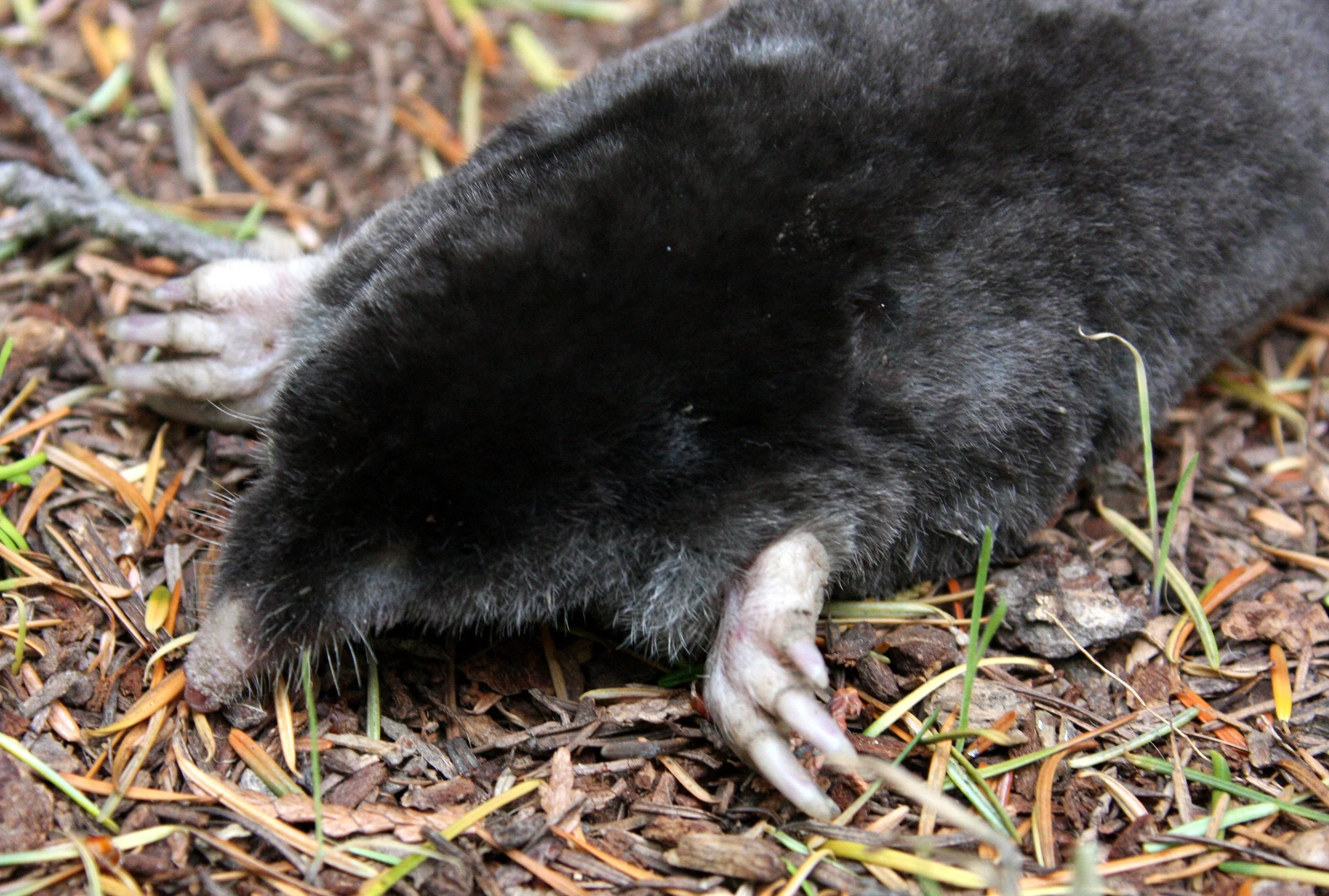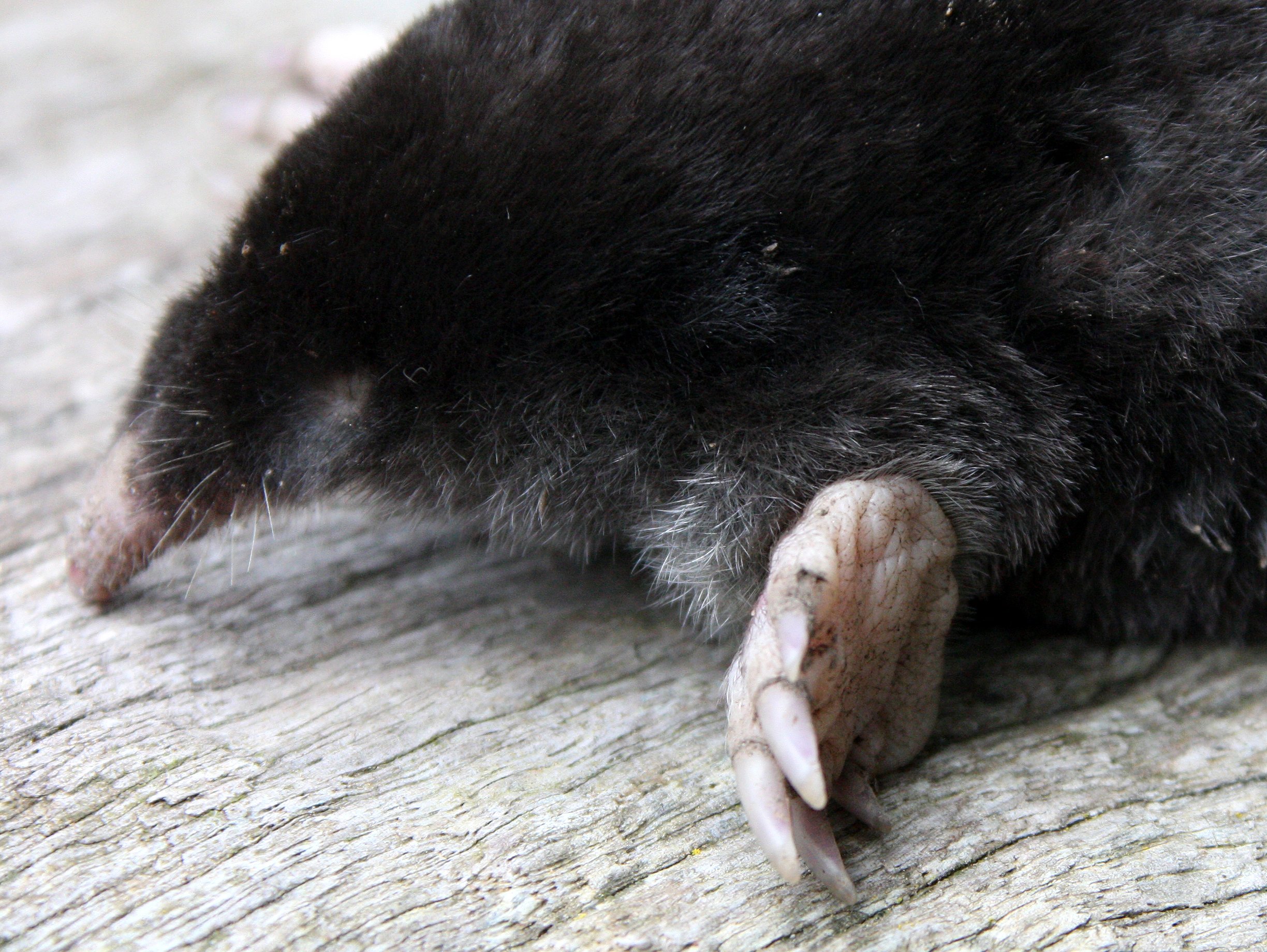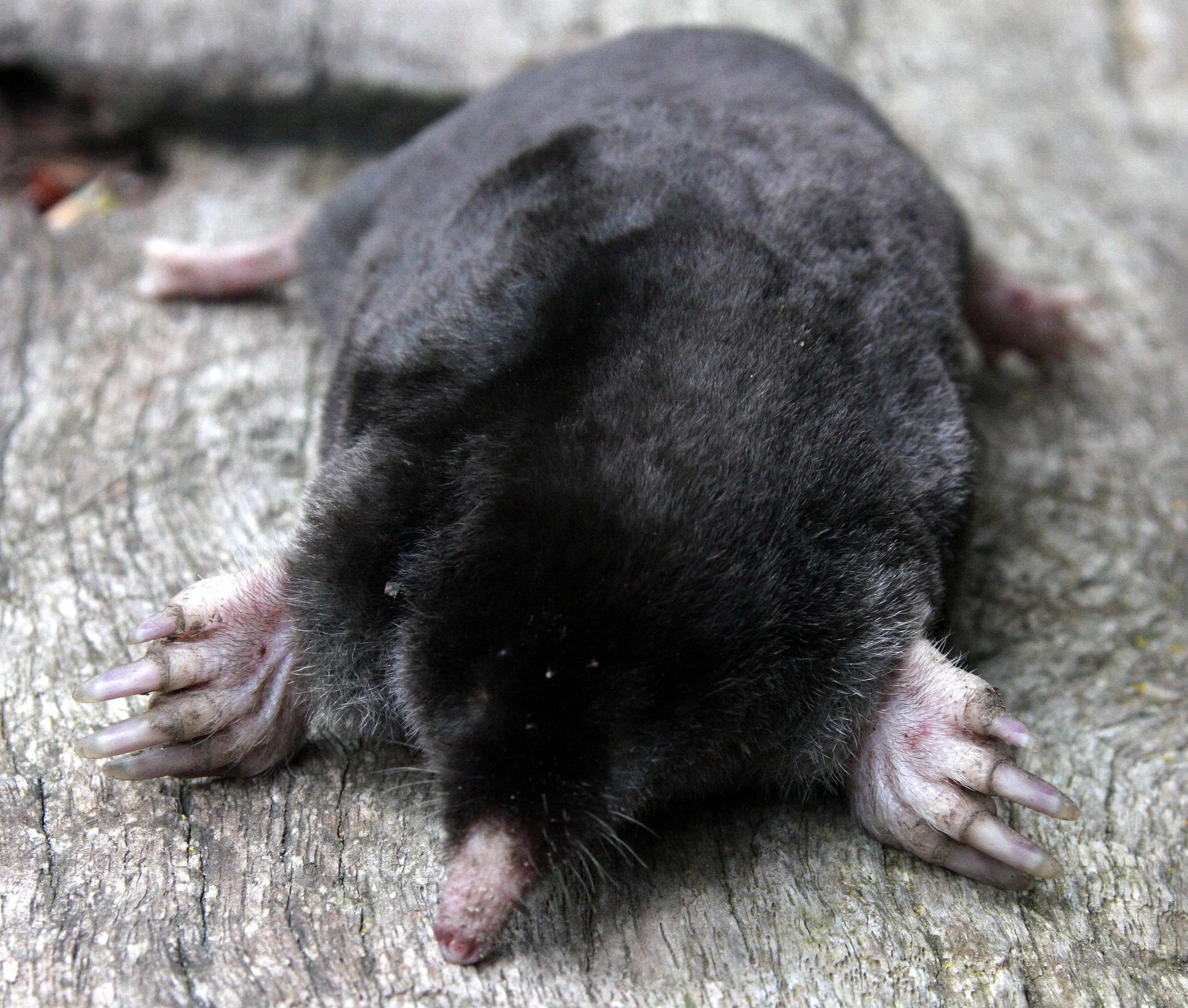

Order Eulipotyphla (= 'Lipotyphla' - Afrosoricida = 'Erinaceomorpha' + 'Soricomorpha')
Family Erinaceidae
Subfamily Galericinae: gymnures or moonrats
Bornean Moonrat (Echinosorex gymnura alba)
Family Soricidae
Townsend's mole (Scapanus townsendii)
American pygmy shrew (Sorex hoyi)
The Apennine shrew (Sorex samniticus)
Trowbridge's shrew (Sorex trowbridgii)
Vagrant Shrew (Sorex vagrans)
Asian highland shrew (Suncus montanus)
Asian house shrew (Suncus murinus)
Moonrat (Echinosorex gymnura)
The Moonrat (Echinosorex gymnura) is a southeast Asian species of mammal in the family Erinaceidae (hedgehogs and gymnures). It is the only species in the genus Echinosorex. The moonrat is a fairly small, primarily carnivorous animal which, despite its name, is not closely related to rats or other rodents. The scientific name is sometimes given as Echinosorex gymnurus, but this is incorrect.
The moonrat has a distinct pungent odor with strong ammonia content, different from the musky smell of carnivorans. There are two subspecies: E. g. gymnura is found in Sumatra and the Thai-Malay Peninsula; E. g. alba is found in Borneo. In the former the head and frontal half of the body are white or grey-white; the remaining is mainly black. The latter subspecies is generally white (alba means white in Latin), with a sparse scattering of black hairs; it appears totally white from a distance. Those from western Borneo tend to have a greater proportion of black hairs than those from the east, but animals from Brunei appear intermediate.[4] Largely white E. g. gymnura also occur, but they are rare.
Moonrats inhabit most jungle terrain in southern Myanmar, Peninsular Thailand, Peninsular Malaysia, Borneo and Sumatra. Although they are closely related to the short-tailed gymnure (Hylomys suillus) and to the hedgehog, full grown specimens more closely resemble large rats, with which they share similar habits and ecological niches.[8] In Borneo, they occur at many sites throughout the lowlands and up to 900 m in the Kelabit Highlands. They appear to be absent or rare in some localities, possibly due to a shortage of suitable food.
Moonrats are nocturnal and terrestrial, lying up under logs, roots or in abandoned burrows during the day. They inhabit moist forests including mangrove and swamp forests and often enter water. In Borneo, they occur mainly in forests, but in peninsular Malaysia they are also found in gardens and plantations. They feed on earthworms and various small animals, mostly arthropods. The moonrat is a host of the acanthocephalan intestinal parasite Moniliformis echinosorexi.
Moonrats release strong odours with a strong ammonia content to mark the edges of their territories and warn other moonrats to stay away with threatening hisses also to ward off predators. Adults live alone. When they are preparing to have young, they will make nests mostly from leaves. Females usually have two babies at one time.
The moonrat is an omnivore, known to eat a wide range of invertebrates—for example, worms, insects, crabs and other invertebrates found in moist areas. They will also eat fruit, and occasionally frogs or fish.
Bornean Moonrat (Echinosorex gymnura alba) seen at Tabin Reserve, Malaysian Borneo








Townsend's Mole (Scapanus townsendii)
The Townsend's Mole (Scapanus townsendii) is a fossorial mammal in the family Talpidae, and is the largest North American mole. It was named after the American naturalist John Kirk Townsend. The name was selected at the request of Thomas Nuttall as a patronym to honor Townsend's contribution.
It is found in open lowland and wooded areas with moist soils along the Pacific coast from southwestern British Columbia to northwestern California. This animal's total range in Canada is estimated to be 20 km² (7.7 sq mi).
Townsend's mole is classified as Least Concern by the IUCN; however, in Canada it is considered an endangered species.
It has velvety black fur, a pointed snout and a short, thick, a tail with barely any hair. It is about 21 cm (8.3 in) in length including a 4 cm (1.6 in) tail, and weighs about 138 grams (4.9 oz). Its front paws are broad and spade-shaped, specialized for digging; the rear paws are smaller. It has 44 teeth. Its ears are not visible and it has small eyes. It is similar in appearance to the smaller coast mole.
Townsend's mole spends most of its time underground, foraging in shallow burrows for earthworms, small invertebrates and plant material. It is active year-round. It is mainly solitary except during mating in late winter. The female has a litter of two to four young in a deep burrow.
Townsend’s Mole (Scapanus townsendii) Lake Farm Washington USA






















American Pygmy Shrew (Sorex hoyi)
The American Pygmy Shrew (Sorex hoyi) is a small shrew found in Northern Alaska, Canada, and the northern United States, south through the Appalachian Mountains. It was first discovered in 1831 by naturalist William Cane in Georgian Bay, Parry Sound.
This animal is found in northern coniferous and deciduous forests of North America. It is believed to be the second-smallest mammal in the world, but has an extremely large appetite for its size. Due to its fast metabolism, it needs to eat constantly. It digs through moist soils and decaying leaf litter for food.
The American pygmy shrew is the smallest mammal native to North America and is one of the smallest mammals in the world, being just slightly larger than the Etruscan shrew of Eurasia. Its body is about 5 cm (2 in) long including a 2-cm-long tail, and it weighs about 2.0 to 4.5 g (0.07 to 0.16 oz). Its fur is generally a reddish or grayish brown during the summer, and a white-gray color during the winter. The underside is generally a lighter gray. This animal molts about twice a year, once during late summer, and again during the spring. It has a narrow head with a pointed nose, and whiskers. The eyes are small and well hidden. The primary senses used for hunting are hearing and smell.
Sorex hoyi was originally placed in the genus Microsorex, which was a subgenus under Sorex until more research had been done. The American pygmy shrew is in the order Soricomorpha and the family Soricidae. Its two closest relatives are the smokey shrew (S. fumes) and the large-toothed shrew (S. macrodon). This genus is believed to have appeared in the late Miocene.
Pygmy shrews are distributed throughout the boreal areas of North America. This ranges from Northern Alaska, to the Rocky Mountains, through the Great Lakes region, to the Appalachians, to the eastern side of Canada. Although S. hoyi prefers moist habitats, it has been recorded to live in areas with both wet and dry soil, but if it is living in a more arid environment, it needs to have a source of water nearby.
Primarily insectivorous, this animal forages in moist soil and dead leaves to find its prey. Because of the pygmy shrew's small size, its diet primarily consists of insects and insect larvae, while the larger shrews eat insects and worms.[8] Its diet is almost exclusively protein-based. To stay alive, the pygmy shrew has to eat three times its body weight daily, which means capturing prey every 15 to 30 minutes, day and night; a full hour without food means certain death. Because of this high metabolism, the pygmy shrew never sleeps more than a few minutes at a time, as it is in a constant search for food. Although due to its small body size it is always losing body heat, being small has its advantages during the winter when food is scarce. Predators of the American pygmy shrew include hawks, brook trout, owls, snakes, and domestic cats.
American Pygmy Shrew (Sorex hoyi) McKee Marsh, Suburban Chicago



Apennine Shrew (Sorex samniticus)
The Apennine Shrew (Sorex samniticus) is a species of shrew in the family Soricidae. The mammal is endemic to Italy. Spotted dead on trail at Abruzzo National Park.


Trowbridge's Shrew (Sorex trowbridgii)
Trowbridge's Shrew (Sorex trowbridgii) is a species of mammal in the family Soricidae. It is found in southern British Columbia in Canada and in Washington, Oregon, and California in the United States.
Trowbridge's shrew is found along the western coast of North America. They occur in the extreme southwest of British Columbia, south of Burrard Inlet. They are found in the western part of the states of Washington and Oregon. In northern California, the distribution forks. In the west, the population continues south through the coast range to Santa Barbara County. Through eastern California, the population extends south through the Warner Mountains and the Sierra Nevada Mountains to Kern County. Different subspecies are found in different regions of the geographic range. They are found from sea level up to an elevation of 1,820 m (5,970 ft).
Trowbridge's shrew resides in forested areas where the ground may be littered with debris for cover. After logging in an area, they may remain, if sufficient ground cover is present. They are found in both dry and moist forests, as well as in swampy woodlands. Populations on Destruction Island off the Washington coast live in deep rank grass near salmonberry patches. They are less likely to be found near streams. In the southern reaches of their range, they may be found in chaparral.
Sorex trowbridgii - Seen deceased on Lake Farm Trails, Washington State








Vagrant Shrew (Sorex vagrans)
The Vagrant Shrew (Sorex vagrans), also known as the wandering shrew, is a medium-sized North American shrew. At one time, the montane shrew and the Orizaba long-tailed shrew were considered to belong to the same species.
This animal inhabits open and wooded areas in western Canada and the United States west of the Continental Divide. In Canada, it is found in southern British Columbia, including Vancouver Island, and as far east as extreme south-western Alberta. In the United States, it is found throughout most of Washington, Oregon, and Idaho, as far south as central California, in northern and central Nevada, northern Utah, and western Montana and Wyoming.
Their preferred habitat appears to be wet grassland and meadows, ranging from alpine tundra to swampland, and they are often found close to rivers or other sources of water. They are also found in open coniferous forest, but only rarely in dense woodlands. Because they often use fallen logs as cover, they prefer areas with moderate amounts of woody debris, and they may also prefer areas with more acidic soils than other local shrew species. One subspecies is found only in salt marshes.
There are three recognised subspecies:
Sorex vagrans halicoetes - salt marshes in central California
Sorex vagrans paludivagus - central Californian coast
Sorex vagrans vagrans - throughout the remainder of the range
Pleistocene fossils attributed to the species have been reported from Arkansas, New Mexico, and Texas. However, such fossils can be difficult to distinguish at the species level, and may represent close relatives such as montane or Pacific shrews.
Vagrant Shrew (Sorex vagrans) - Lake Farm Trails Washington State











Asian highland Shrew (Suncus montanus)
The Asian highland Shrew (Suncus montanus) is a species of mammal in the family Soricidae. It is found in India and Sri Lanka. Its habitat is subtropical or tropical dry forests. It is threatened by habitat loss. It is known as ශ්රී ලංකා කදු හික් මීයා in Sinhala.
The head and body reach 9–11 cm (3.5–4.3 in) in length. The tail is around 7 cm (2.8 in) long. It is dark bluish-brown to black above and paler below. The pelage may be bluish-gray at the base. Some adults are reddish brown. The fur is soft and velvety and hairless areas are pinkish.
Suncus montanus - Silent Valley National Park Kerala India










Asian House Shrew (Suncus murinus)
The Asian House Shrew (Suncus murinus) is a shrew species native to South and Southeast Asia that has been listed as Least Concern on the IUCN Red List since 2008 because of its large population and wide distribution. It has been introduced in several West Asian and East African countries. It is considered an invasive species and implicated in the demise of several island lizard species.
It is also called house shrew, grey musk shrew, Asian musk shrew or Indian musk shrew.
The shrew is worshipped as the vehicle mount of the foremost god of Hinduism, Ganesha. Thus it is a taboo to kill a shrew among Hindus.
The house shrew has a uniform, short, dense fur of mid-grey to brownish-grey color. The tail is thick at the base and a bit narrower at the tip, and is covered with a few long, bristle-like hairs that are thinly scattered. They have short legs with five clawed toes. They have small external ears and an elongated snout. They also emit a strong odor of musk, derived from musk glands that are sometimes visible on each side of the body. The odor is especially noticeable during the breeding season.
Like all shrews, the Asian house shrew is plantigrade and long-nosed. The teeth are a series of sharp points to poke holes in insect exoskeletons. It is the largest of the shrew species, weighing between 50 and 100 g and being about 15 cm long from snout to tip of the tail.
The Asian house shrew is native to South and Southeast Asia and was introduced by humans to eastern Africa, Arabia, Madagascar, the Philippines and other islands in the Indian and Pacific Oceans.
The Asian house shrew is a voracious insectivore with little resistance to starvation. It is active during the night, spending the day in a burrow or hiding place in human habitations. They breed throughout the year, with each female averaging two litters per year. The gestation period is one month. One to eight young are born per litter, usually three young, in a nest made by both of the parents, wherein the young stay until they are nearly adult. It starts breeding when it is around one year old.
Studies on this shrew have suggested its suitability for use in laboratory studies of reproduction and nutrition.
It is widespread and found in all habitats, including deserts and human habitations.
The house shrew has a habit of moving quickly along the edges of the walls when it enters human habitations. As it runs it makes a chattering sound which resembles the sound of jingling money, which has earned them the name "money shrew" in China. When alarmed, the house shrew makes an ear-piercing, high-pitched shriek, resembling the sound of nails scraping a chalkboard or a metal fork scraping glass, which repels house cats. Predators also leave the house shrew alone because of its musky smell and even when they catch one by mistake they will rarely eat it.
Another habit of this shrew, shared with the white-toothed shrews of Europe, is that when a mother and its young travel the first will hold on to the mother's fur with its teeth, and the subsequent young will do the same with the sibling in front of it.
It is often mistaken for a rat or mouse and killed as vermin. In general it is beneficial to humans because its diet consists mostly of harmful insects such as cockroaches, and even house mice. It can therefore be considered as a biological pesticide. Unlike rats, population levels of house shrews remain low. Despite its use as an insect control, it can be unpopular due to the strong odour of its droppings, which it may deposit in human dwellings behind kitchen cupboards, etc. It can also take to eating human food such as meat in kitchens, or dog or cat food. It is known to occasionally kill young chicks, making it unpopular with farmers, although rats probably kill more chicks, and more quickly. The way it is said to attack chicks, by first biting a tendon, immobilizing it and then killing and eating it, could indicate that it has a venomous bite that paralyses, as at least two other shrews species have (i.e. the Eurasian water shrew and the Northern short-tailed shrew).
Individuals in this gallery come from Phong Nga Viet Nam and Bandavgarh India.





























